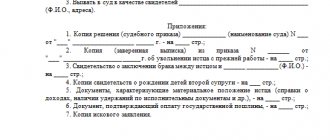The main grounds for recalculating the amount of alimony
There are quite a few reasons that can be considered legal grounds. The main ones:
- If the health of the alimony payer has changed for the worse. For example, disability or disability.
- If there are new dependents. Usually, the reason can be considered the appearance of another child (especially if you have to pay for it too).
- If the child has his own source of income. For example, a sixteen-year-old teenager begins to officially work and receive wages.
- If the total monthly income of the alimony obligee decreases significantly. But this does not take into account credit obligations.
- If the child is fully supported by the state. In particular, if we consider children who are raised in orphanages or boarding schools.
But these grounds mean nothing if they are not supported by relevant documents.
What should not be used as arguments
There are certain statistics indicating which reasons will not be sufficient grounds for reducing payments. Moreover, they can only do harm. In other words, you should avoid the following statements:
- thanks to alimony, the party that receives the money gets rich (in most cases this is said about the child’s mother);
- the party who takes care of the child received an expensive inheritance and because of this she does not need alimony;
- the party who lives with children closed the loan, and she had “free” money.
That is, all claims regarding a woman’s income are considered irrational.
Amount regulation
You can count on a reduction in alimony payments in the case where the financial condition of the payer really does not allow making deductions at the previously established level, for example, due to the appearance of another family and child or a serious illness.
In addition, the amount of payments at a certain stage of life can significantly exceed the amount of money that is enough to support a needy child.
The court often has a positive attitude towards reducing alimony payments if the following grounds exist:
- the payer has been diagnosed with a disability of 1-2 groups, a serious illness that does not allow him to maintain earnings at the proper level;
- the child for whom alimony is assigned has reached the age of 14 and has begun to provide for himself financially through work or entrepreneurial activity;
- the child inherits movable or immovable property that generates income, for example, deposits, securities or an apartment that is rented;
- assignment of payments for two children from different mothers with whom he does not live;
- the debtor has a new family and the need to support newborn or adopted children;
- the presence of other dependents or alimony obligations of the payer;
- a significant increase in the payer’s earnings, as a result of which alimony, which is calculated as a percentage of income, impressively exceeds the necessary funds for financial support of the child;
- a significant decrease in the payer’s earnings or loss of income from which deductions were calculated.
- the child for whom the payments are issued is fully supported by the state in an orphanage, boarding school or other institution.
Methods of transferring alimony: which is the most optimal? The answer is presented in the article “How child support is transferred.” You can find out how you can reduce child support here.
Where to contact
If there are still grounds for reducing payments, you can contact special authorities to recalculate their amount downwards. As a rule, you need to go to court, where the judge who decided the current amount of payments will take care of their reduction. Of course, if there are reasons for this.
Documents must be submitted at the place of residence of the person receiving alimony. Usually, the problem can be resolved within a month. But subject to the submission of all documents and sufficient grounds.
Penalty
Penalties are penalties for late or non-payment. Collection of debt for a penalty occurs after the recipient of alimony applies to the court or executive service.
If a voluntary agreement on alimony has been concluded, then the penalty is calculated in accordance with its provisions, drawn up at the discretion of the parties. If the penalty is determined by the court, then its value is 0.5% of the total amount of debt for each day of delay.
To collect a penalty, the recipient of payments in a lawsuit must convince the court that the debt arose through the fault of the payer. If the court sides with the debtor, the fine may not be imposed or its amount will be reduced.
How to reduce previously established payments
If you have already been assigned a payment, its size can be changed by using the following methods:
- Draw up a voluntary agreement between the parties with updated terms. But only if the alimony recipient and the alimony obligee agree to the new conditions. The new agreement must be certified by a notary. It is important that the amount of payments is not less than the minimum established by the court.
- Go to court and force the terms to change. It is used only if conditions have arisen that can be considered a worthy reason for changing the amount of payments made for raising a child
Let's consider these cases in more detail.
Determination through court
Recalculation of alimony in court has limitations:
- you need to contact the department located at the defendant’s address;
- in case of accrual of interest on income, the next payment is calculated in the same way (the income has changed, the amount will also decrease).
As a rule, alimony payers want a fixed amount of payments to be established. It is possible in the following situations:
- the parent obligated to support does not have a regular income;
- receives earnings in foreign currency;
- income is received irregularly and is not standardized.
You can also go to court in other situations when earnings cannot be tied to the standard. But it is possible to use percentage recalculation of alimony if a person has a stable and constant income.
Agreement of the parties
It happens that the receiving party wants to refuse alimony. This usually happens if a woman wants to break all ties with her husband, including financial ones. The same rule applies if they have agreed on a one-time payment instead of regular contributions. If this happens after the court has made a decision, you will need to write a refusal. Nevertheless, it is impossible to completely refuse money, since parents are only representatives of children, and therefore cannot act against their interests.
Algorithm of actions to reduce the amount of payments for children
The payer's procedure is as follows::
- Collecting primary documents with which you will have to go to a family lawyer for a consultation.
- Direct consultation with a specialist.
- Carrying out recommended actions, collecting additional documents.
- Pre-trial dispute resolution.
- Drawing up and filing a claim in court.
- Defending a position at meetings.
The procedure may vary. For example, in the second stage the payer may conclude that:
- The grounds for reducing alimony are unconvincing.
- There will be painstaking work to collect the evidence base.
- It is better to entrust the entire process to a family lawyer.
In another case, already at the fourth stage the parties can come to an agreement and draw up a new agreement. This makes the remaining steps pointless. The list of actions can continue if the trial is lost in the first instance. There is an appeal and cassation pending. In addition, the parties can enter into a settlement agreement during the consideration of the case in court.
Directly filing a claim in court to reduce alimony is the tip of the iceberg. Before this, there will be a labor-intensive process of assessing prospects, collecting evidence and pre-trial settlement of the dispute.
There are three ways to file a claim:
- Through a proxy;
- Directly through the court office;
- By mail sending a package of documents.
In the first case, a power of attorney must be drawn up and certified by a notary. When sending an application by mail, a letter of recommendation is drawn up with a description of the contents and a notification of delivery.
You can read more about how to apply for a reduction in alimony in this material.
Specific ways to switch to reduced alimony payments
There are several ways to reduce your child support amount. Here are some of them:
- file a lawsuit to change the interest accrual to a fixed rate (or vice versa);
- reduce the share payment, which is greater than the minimum specified in the RF IC;
- agree with the other parent on a new amount that would be affordable for the child support payer.
But in any case, paying child support for a minor child is the responsibility of the parent.
Features of the transition from lobar to solid form
Typically, such a transition is carried out if the payer does not have a regular income, so it will not be possible to calculate interest on the salary received. If a person had a job at the time alimony was established, from the moment of losing this job he will have to look for alternative methods of calculation. A fixed rate is the best option if income is not systematic or regular.
Transition to a shared form of calculating alimony
If alimony was previously calculated using a fixed method, but then the alimony payer got a well-paid job and his income increased significantly, he will also have to look for an alternative. In this case, you can recalculate according to the share principle. Especially if the person is dependent on another child. Then it will be possible to reduce the amount of payments for one child, taking into account that another has appeared in the family, and he is also dependent on the alimony payer.
The calculation is based on the fact that in the case of a fixed rate, a child needs to pay 25% of income, and for two children 50%. If we talk about sharing, you only need to pay 33% of your earnings to support two children, which is much more profitable.
General provisions
Payers who expect a reduction in child benefits often make two serious mistakes:
- Rely on one basis;
- They do not consider it necessary to carefully justify the reason for reducing alimony.
Most often this applies to cases where the payer has a second child from another woman. The law (Article 81 of the RF IC) directly states that if there are two children, each of them has the right to one-sixth of the total earnings of their father or mother (which happens less often). If previously the amount of payments was set at a quarter of the salary, the payer has the right to reduce them by a third (from 25% to 16.5%).
On numerous forums, “experts” indicate that the court will definitely satisfy the payer’s claims, and the amount of alimony will be reduced. However, judicial practice shows that this is not always the case. Repeated cases where the plaintiff was refused for the following reasons :
- Inconclusive evidence;
- The absence of a cause-and-effect relationship between the circumstances and the requirements to reduce the amount of alimony;
- Judge's position.
The legislator traditionally stands on the side of children and single mothers. Courts are reluctant to satisfy demands related to a reduction in the level of financial support for these categories.
To increase the chances of success, the payer must:
- Carefully document all circumstances that indicate the need to reduce alimony.
- Carry out work aimed at pre-trial settlement of the dispute.
- Contact a family lawyer for help.
You cannot do without a practicing specialist in the field of family law. At a minimum, you need to come to him with documents for a consultation so that he:
- Assessed the prospects of the case.
- He pointed out doubtful points and evidence.
- I outlined the further procedure.
This step reduces the payer’s risk of losing time and money and increases the chances of winning the case in court or pre-trial settlement of the dispute. If you ignore contacting a specialist, the plaintiff risks making mistakes:
- In substantive and procedural law;
- When requesting documents and filing a claim;
- When communicating with the child's mother.
In the latter case, the possibility of settling the dispute without trial is excluded. The dispute can be completely resolved pre-trial in two cases, if the amount of alimony is:
- Determined by agreement between parents;
- It is actually paid without a contract or a court decision.
If the court has determined the amount of alimony by decision or order, you will have to turn to it in any case to resolve the dispute. But even in this case, pre-trial dispute resolution simplifies the process :
- A statement is being prepared, not a lawsuit.
- The court issues an order.
- The state duty is two times less.
- There is no need for expensive services of a family lawyer.
Where a thorough trial could take months, the writ is issued within a business week. According to the law, 5 days are allotted for it; in practice, the process drags on for 2-4 weeks, but it is faster and easier than considering a claim.
How to submit documents to reduce alimony payments
To get a positive response to your request, first of all, you need to prepare the relevant documents. They must confirm the conditions under which a person is entitled to change payment requirements. The whole procedure consists of the following steps:
- Collection of documents. The list of required papers includes various certificates from work (to prove that income has decreased), medical certificates of deteriorating health (if it affects the amount of funds received), etc.
- Writing a claim. It is important that the application is written correctly, otherwise the court simply will not accept it. To do this, it is advisable to seek help from a professional.
- Submission of documents. They must be filed with the court at the place of residence of the alimony recipient. If you send the papers to the wrong department, most likely you will simply waste time.
If the documents were accepted, but for some reason you were not satisfied with the court’s decision, you can always file an appeal. But only if the deadlines provided for by law have not expired.
Background to the trial
The case is not quite typical: during a divorce, the father (by no means a poor man) kept his children. And after some time he filed for alimony for his ex-wife (let's call her A.). We won’t delve into the reasons for the showdown (each hut has its own rattles), let’s just say that A. was awarded alimony.
For some time she worked happily in the district clinic and paid what she was supposed to. During this time, one child managed to reach the age of 18, and child support began to rely only on the second.
A. began to have health problems, and she was forced to resign from the clinic where she worked, recovered for some time and lived on small savings. During this time, the alimony debt grew by the estimated amount per month. As the bailiffs explained to A., since there is no employment, they calculate alimony as a percentage of the average earnings, which they take from Rosstat. And according to Rosstat, a medical worker with a specialization like A. should receive as much as 50 thousand rubles. per month at least (where Rosstat gets such data, and even for the Tver region is a separate question).
How to approve a voluntary agreement
The amount of alimony can only be determined if both parties agree to the prescribed conditions. To achieve this you need:
- Discuss the problem with the other party. People must agree on what payment they can make and by how much to reduce it.
- Amendments to the agreement.
- Making changes legal by contacting a notary to certify the updated document.
All that remains is to follow the updated terms and conditions. If this is not done, you can go to court.
What did the court decide?
A. submitted to the court a description of her situation (with documents confirming her long illness). She also provided updated data from “My Tax” for the six-month period.
The judges took into account that collecting alimony in the amount required by the ex-husband would lead to the withholding of almost all self-employment income (that is, the judges considered self-employment income as officially confirmed income).
And they made a decision: to satisfy the requirement to establish alimony in a fixed amount. A fixed amount should be assigned in the amount of 1/2 the minimum wage per child in the region of residence of the child - in Moscow: the fixed amount of alimony is set at 7,612 rubles. 50 kopecks per month.
When can changes be refused?
Reducing child support is not an easy procedure, because it affects the interests of the child . Therefore, it is not surprising that such requests are often denied, especially if there is even the slightest reason for this. If you are denied, most likely the court did not find your circumstances sufficient to deny your child his legal remedies. After all, as was already said at the beginning, supporting a child is not a cheap task, and it is not so easy for one parent to cope with it.
However, it will be interesting in which cases the chances of getting rejected are much higher:
- if the main argument is that the minor owns some property that does not generate profit (it is doubtful that the child will engage in entrepreneurial activity);
- if the other parent with whom the child lives has a high financial position (in other words, the father must pay money, even if the child’s mother is rich and could provide for her heirs on her own);
- if the child receives a pension;
- if the alimony payer has credit obligations that “eat up” most of the income.
You cannot rely on the listed reasons, since the court will not perceive them as a sufficient basis. But they can be an excellent reason for the parties to come to a voluntary agreement. For example, if the father has large loans, the child’s mother can meet him and temporarily reduce the amount received.
Position in most cases
Alimony is a type of financial assistance to disabled or needy persons: minor children, mothers raising a child on their own, disabled relatives or parents who cannot provide for themselves due to age.
The most frequent and significant disputes regarding child support arise between the parents of a joint child. In this case, the parent with whom the child remains to live has to seek help from the other by collecting alimony through the court. Payments are assigned as a share of the payer’s earnings or in a fixed sum of money.
If an agreement is reached between the parents of a minor regarding payments, then payments can be legally secured through a voluntary alimony agreement certified by a notary. In this case, reducing the amount of payments by mutual agreement will also not be difficult - you just need to conclude an additional agreement.
However, if the payer who makes payments according to a court decision wants to reduce payments, then the recipient of alimony will not always meet the other party halfway and will defend his position and the interests of his child in every possible way.
Practice in cases involving alimony disputes shows that courts can be guided by different beliefs: some refuse to reduce payments to the payer, protecting the interests of the child, others reduce alimony based on the unsatisfactory situation of the payer or the appearance of a new family.
Submitting a claim to court
Print out four copies of the claim. Sign each copy. Make copies of documents (attachments) in triplicate and attach them to three copies of the claim. Attach a receipt with paid state duty to one of these three copies. The claim can be brought to court in person or sent by registered mail.
If you carry it in person, the court office will put a stamp on your copy (without attachments) indicating receipt of the claim, and three copies with attachments will remain in the office. If you send by registered mail, then send only three copies with attachments. You leave the fourth one without applications for yourself.
If you brought the claim in person, then after 5 days you can start calling the court and find out if a court hearing has been scheduled. You can find the telephone number of the assistant judge on the court website.
Appealing a court decision
The procedure for appealing a court decision depends on one factor - whether it has entered into legal force or not. If accepted, a cassation is filed, if not, an appeal is filed.
The other party may file an objection to the cassation or appeal. The cassation or appeal court has the right to cancel the decision in whole or in part, or issue a new decision, which comes into force immediately after adoption.
On appeal
The grounds for filing an appeal are misinterpretation, failure by the judge to apply the law, or other procedural violations.
The complaint is submitted as follows:
- The applicant draws up the document itself. It specifies the grounds for appeal and demands for cancellation of the initial decision with reference to the rules of law violated by the judge when making it.
- The appeal is filed with the judicial authority that made the first decision. After the expiration of the procedural period, the document is sent to the appeal board - the district court. The case is heard there.
- According to Art. 327.2 of the Code of Civil Procedure of the Russian Federation, an appeal is considered for no more than 2 months.
Based on the results, an appeal ruling is issued to cancel the decision of the first instance court.
In cassation
If the court decision has entered into legal force or the citizen does not agree with the appeal ruling, an appeal is made through the cassation procedure within 6 months (Article 376 of the Code of Civil Procedure of the Russian Federation). To do this, the complaint is filed with the court of first instance, which made the contested decision.
The step-by-step appeal looks like this:
- A party dissatisfied with a court decision or an appeal ruling shall file a cassation appeal, indicating the grounds for appeal and attaching documents.
- Documents can be presented in person at the court reception or by mail.
- After consideration of the materials, a court hearing is scheduled, and the parties are sent by mail a ruling to transfer the complaint to the cassation body for consideration.
After examining the case, the court issues a ruling to cancel the previous decision or appeal ruling.
Important! In both cases, before filing an appeal or cassation, you will have to pay a state fee - 50% of the fee to the court of first instance.
How to write an application for alimony reduction
A unified application form is not established by law, but it must comply with the requirements of Art.
131 Code of Civil Procedure of the Russian Federation in terms of content. A sample and a blank form can be downloaded from the official website of the court or on our website. What information is indicated in the application:
- name of the judicial authority;
- Full name, registration address, passport details of the plaintiff;
- Full name, registration or residence address of the defendant;
- information about the decision to collect alimony made by the court last time: date, number;
- Children's full names, information from children's birth certificates;
- on what grounds should payments be reduced;
- references to legal norms;
- claims: reduce the amount of alimony, change the payment method from shared to fixed, etc.;
- a list of attached documents;
- number and signature.
Sample and form of statement of claim to court
The application is drawn up in three copies: one each for the court, the defendant and the plaintiff.
Sample claim
Objection to the statement of claim for the recovery of alimony
Reducing the amount of alimony
Is it possible not to pay child support at all?
Regardless of whether parents work or not, they are obliged to support their minor children (clause 1 of Article 80 of the Family Code). Therefore, to be exempt from child support, the child must be 18 years old or parental responsibilities must be removed from the citizen (renunciation of paternity):
- Adoption of a child by another person
- Challenging paternity
In other cases, alimony cannot be completely cancelled, but its amount can be reduced.
Cancellation of child support
Examples
Let's consider the case of reducing child support based on the presence of other children. The plaintiff asked to reduce payments for a child from his first marriage from 1/4 to 1/6, since he had a child from another marriage. The court refused because, taking into account deductions, the financial situation of each member of the plaintiff’s family exceeds the amount of payments for the first child.
Another case. The plaintiff requested a reduction in alimony, as arrears had arisen due to dismissal and loss of documents for employment at a new job. The court rejected the claim because it was established that at the time of consideration of the case the applicant was working and receiving a stable income.








